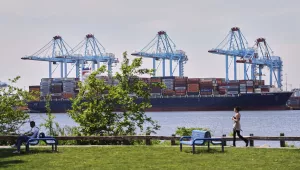The “bicycle theory” used to be a metaphor for international trade policy. Just as standing still on a bicycle is not an option — one has to keep moving forward or else the bike will fall over – so it was said that international trade negotiators must continue to engage in successive rounds of liberalization, or else the open global trading system would be pulled down by protectionist interests. I don’t know if the theory was ever right. (And, to be honest, I don’t entirely understand why forward movement keeps a bicycle from falling over.) But if we had stood still on trade policy over the last three years we would be a lot better off than where we are now.
Trade is faltering — global trade volumes shrank an alarming 1.1 percent over the 12 months — but the cause is a chaos of inept riders on colliding bicycles, rather than the inertia of special interests.
Let’s look ahead to a day when grown-ups are again riding the bicycles. What sort of trade policy should they pursue? It is not a futile question to ask, even though many Democratic politicians share Trump’s view that we need to “get tough” with trading partners.
A historical example illustrates how political trends can shift. The US Smoot-Hawley tariff of 1930 and the foreign retaliation that swiftly followed were the height of protectionist folly. But eventually, they came to be widely perceived precisely as folly. The Roosevelt Administration passed the Reciprocal Trade Agreements Act in 1934. After World War II it became the basis for several generations of multilateral trade liberalization, which in turn contributed to a long period of widespread peace and prosperity. Throughout, Smoot-Hawley was remembered as the cautionary tale to be avoided.
Deep versus shallow integration
We could do worse than return to the post-war formula of negotiating reciprocal elimination of tariffs. The suggestion sounds old-fashioned. After all, another familiar truism has held that we have largely completed the job of so-called “shallow integration,” that is eliminating such straightforward trade barriers as tariffs and quotas and that further progress now requires “deep integration.” Deep integration would entail mutually agreed rules for regulating the business environment. This involves a lot of potentially worthy measures, to be sure. But it now appears too ambitious.
An ultimate example of deep integration was the 1980s decision by the members of the European Common Market to go beyond the integration of a free trade area, in pursuit of a full European Union and even a common currency. That was a bridge too far, at least for the Brexit-plagued UK.
A promising example of negotiations toward deep integration more recently was the Trans-Pacific Partnership of 2015. It included steps of interest to business, such as some regarding intellectual property rights and investor-state dispute settlement, as well as steps of interest to others, such as serious enforcement of labor rights and environmental protections. But Donald Trump withdrew from it, and the Congressional Democrats had been unsupportive anyway.
Technology transfer and market access in China’s auto sector
A salient current example of attempted deep integration is the US demands that Chinese firms refrain from conditioning their willingness to enter joint ventures with American firms — those who wish to set up operations in China — on the sharing of the foreigners’ proprietary technology. Many US economists support these demands. (Few economists, by contrast, support such other Trump objectives in its China negotiations as agreements to manage bilateral trade quantitatively or to stop non-existent “currency manipulation.”)
Many economists, while conceding that Trump’s goal regarding technology transfer in China is valid, would argue that he has gone about it all wrong. The sensible strategy would have been for the US to make a common cause with other major countries to put pressure on China, preferably via multilateral institutions such as the WTO. After all, German auto-makers have as much at stake in China as American firms. Instead, he has imposed tariffs on most trading partners and undermined multilateral institutions. Further, he has given China little reason to enter into a meaningful agreement, by showing that he does not abide by agreements.
Could a successor president, who went about it in a better way, get the job done? Probably not. For one thing, regulating technology transfer would be very tricky in the best of worlds. It is a subtle process. Typically there is not an explicit quid pro quo [to use a newly popular phrase] initiated by the Chinese firm. Still less is there one initiated by the Chinese government. Often the offer of technology-sharing has been initiated by the foreign corporation, to make it attractive to a local firm as a partner in a joint venture. How could a government regulate such a subtle process?
The answer may be for the Chinese government to remove altogether the requirement that foreign firms have a local partner if they want to do business in China. Recent steps in this direction have been taken in the financial sector and the auto sector.
Tear down tariffs
Simpler yet would have been for China to remove its longstanding tariffs against imports, so that American and German firms could have exported autos directly to the Chinese market, an alternative to having to set up production facilities in China. Not only would this outcome have been simpler. It would also have directly benefited American and German workers, rather than facilitating the migration of production facilities to China.
So let’s go back to good old tariff negotiations. The US should remove all the tariffs that it has imposed over the last few years on washing machines, solar panels, steel, aluminum, automobiles, and myriad other products. In return, China should, of course, remove the retaliatory measures it has taken, for example against US exports of soybeans, pork, and other farm products.
But don’t stop there. Turning the clock back to January 2017 would be a big improvement, but we should keep going.
The conventional wisdom of several years ago that “shallow integration” was virtually complete was always an overstatement. We should move to free trade in motor vehicles and as many other sectors as possible. American politicians complain about longstanding European tariffs on US autos, but seem unaware that the US has longstanding 25% tariffs on European light trucks.
One sector that should be a particularly high priority for zero-for-zero liberalization is environmental equipment such as solar panels, turbines, and other inputs into renewable energy. It is ironic that in many countries there are profuse barriers to trade in an industry that has external benefits to all citizens. The European Union has been a leading offender here, but so have been China and the US — even before Trump.
Among the Trump damage that will need to be undone is the abuse of the national security exception [under Article XXI of the GATT]. The system had previously allowed each country to interpret this exception as it saw fit. Most applied it judiciously, knowing that abuse would invite retaliatory abuse. But under Trump, any sector of the economy, from autos to peanut butter, apparently qualifies as essential to national security. New international negotiations could attempt to reinforce language to indicate what specifically qualifies as essential to national security.
Ideally, negotiations would also aim to reduce abuse of such trade remedies as anti-dumping duties, which are usually simple protectionism flimsily masquerading as a defense against the fantasized predatory pricing by foreigners. The WTO on November 1 ruled against the US anti-dumping duties on Chinese products like solar panels, for the first time authorizing China to retaliate with countermeasures ($3.6 billion in levies) against exports of US goods. Both sides would be better off if the US canceled the barriers against these Chinese exports and thereby removed the Chinese need to retaliate.
Even President Trump might see the light and negotiate a big deal that reverses the tariff war, with a declaration of victory. A ray of hope is the possibility of a US-Japan trade deal that would eliminate the threat of US tariffs or quotas on Japanese autos in exchange for Japanese cuts in tariffs on US agricultural exports. Trump allowed the November 13 deadline for his bogus 25% national security tariffs against auto imports from the EU and Japan [under Section 232 of the Trade Expansion Act of 1962] to pass without action. We still don’t know if he deliberately decided not to go ahead or was just not paying attention.
What about trade and inequality?
None of this addresses the point that trade creates losers as well as winners — a point that, supposedly, we all had forgotten about until we needed an explanation of how Trump achieved his majority in the Electoral College in 2016.
Hopefully, we have now learned that tariffs also create losers as well as winners (a lot more losers than winners, in the case of Trump’s trade war). “Get tough” trade policies are not a solution to the problem of within-country inequality.
But trade is only one of a long list of factors that contribute to inequality. Number one on the list is probably technological progress that raises the demand for skilled workers faster than education and training raises the supply of skilled workers.
Regardless of the apportionment of responsibility among the causes of inequality, the list of practical remedies is pretty much the same. In the US it includes expansion of health insurance, pre-school for all kids, infrastructure investment, competition policy, restoration of post-2008 financial regulations, and more progressive taxation.
Some say that until we enact such policies, we should try to reverse globalization in some way. To me, this is a non sequitur. Rather, enact as many of these domestic share-the-gains policies as we can. At the same time, reverse the trade war. But perhaps in the future, we free-traders should be satisfied with an agenda of eliminating tariffs and quotas. Deep integration, it turns out, is very hard.
Frankel, Jeffrey. “Let’s Go Back to Good Old Tariff-Cutting.” December 2, 2019




